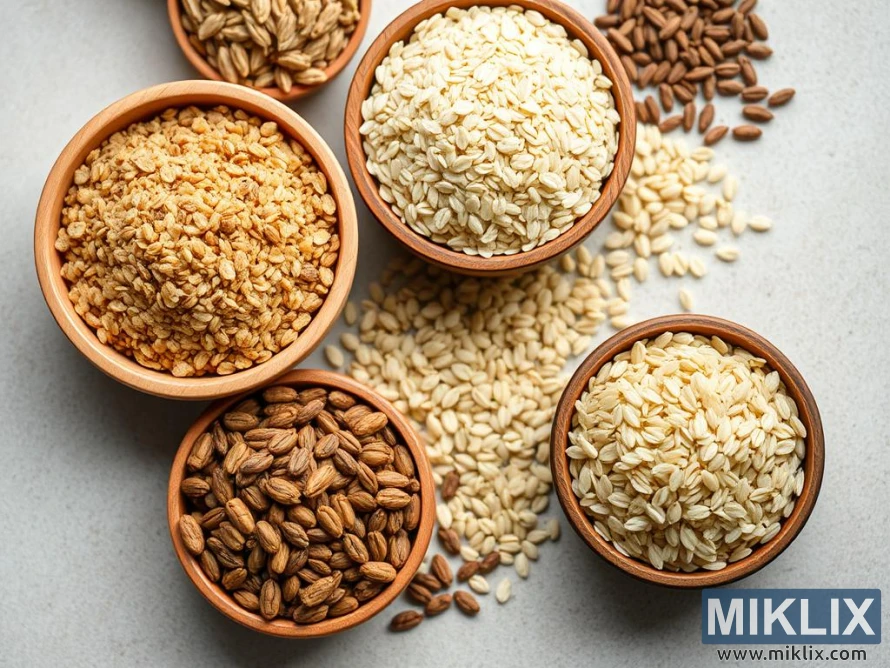Image: Assorted grains and seeds in bowls
Published: July 10, 2025 at 9:26:56 AM UTC
Last updated: September 27, 2025 at 12:59:01 PM UTC
Wooden bowls display puffed grains, rolled oats, and whole grains in earthy tones, with scattered grains adding a rustic, natural touch.
On a softly lit, neutral-toned surface that evokes the calm simplicity of a farmhouse kitchen or a natural foods market, five wooden bowls sit in a gentle arc, each filled with a distinct variety of grains and seeds. The bowls themselves are crafted from warm-toned wood, their smooth curves and subtle grain patterns adding a tactile richness to the scene. They serve as both containers and visual anchors, framing the contents within and reinforcing the organic, earthy aesthetic that defines the composition.
Each bowl holds a different type of grain or seed, showcasing a spectrum of textures and colors that range from pale ivory to deep, toasted brown. One bowl is filled with puffed grains—light, airy, and irregular in shape. Their pale beige color and delicate structure suggest a gentle processing method, perhaps air-popping or light roasting, and they add a sense of volume and softness to the arrangement. Another bowl contains rolled oats, their flat, oval shapes layered like tiny tiles. The oats are slightly glossy, catching the ambient light and revealing their smooth surfaces and subtle golden hue. They evoke warmth and comfort, the kind of ingredient that forms the base of a hearty breakfast or a nourishing baked good.
A third bowl holds whole grains—possibly wheat berries or barley—with a more robust texture and a deeper color. These grains are rounder and more compact, their surfaces slightly rough and matte. Their rich brown tones suggest depth and complexity, hinting at the nutritional density and versatility they bring to a meal. Another bowl may contain sesame seeds, tiny and uniform, their pale color and fine texture offering a visual counterpoint to the larger, more rugged grains nearby. The final bowl features a darker variety of seeds, perhaps flax or millet, with a glossy finish and a rich, earthy tone that adds contrast and visual weight to the composition.
Scattered around the bowls are loose grains and seeds, casually strewn across the surface. These scattered elements break the symmetry of the arrangement, adding a sense of spontaneity and movement. They suggest a moment in progress—perhaps someone was preparing a recipe, measuring ingredients, or simply admiring the variety before them. The scattered grains also enhance the tactile quality of the image, inviting the viewer to imagine the feel of the seeds between their fingers, the sound they make as they fall, the aroma they release when warmed.
The lighting is soft and diffuse, casting gentle shadows and highlights that bring out the textures of both the grains and the bowls. It enhances the natural tones of the ingredients, making the browns warmer, the beiges creamier, and the wood more golden. The overall atmosphere is one of calm abundance—a quiet celebration of whole foods and the beauty of simplicity. There is no clutter, no artificial embellishment—just the honest presentation of ingredients that have nourished generations.
This image is more than a still life; it’s a meditation on nourishment, sustainability, and the quiet joy of working with natural ingredients. It speaks to the timeless appeal of grains and seeds, their role as foundational elements in countless cuisines, and their ability to connect us to the land and to tradition. Whether viewed through the lens of culinary inspiration, nutritional education, or aesthetic appreciation, this arrangement offers a moment of reflection on the richness found in the most humble of foods.
The image is related to: A Round-Up of the Most Healthy and Nutritious Foods

